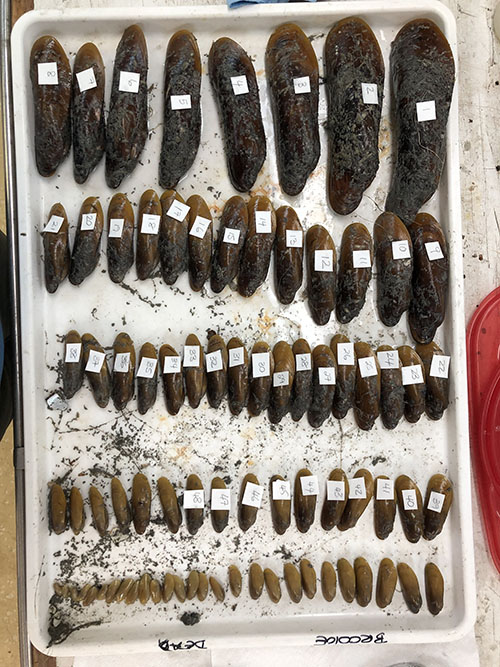
By Caitlin Adams, Operations Coordinator, NOAA Office of Ocean Exploration and Research

This octopus was seen at our dive at Blake Ridge Seep. Image courtesy of Ivan Hurzeler and DEEP SEARCH 2019 - BOEM, USGS, NOAA, ROV Jason, ©Woods Hole Oceanographic Institution. Download larger version (jpg, 5 MB).
The end has snuck up on us yet again. Somehow five days have elapsed since my last update, and we’re headed to the dock tomorrow afternoon. In those five days though, we’ve done quite a lot: we explored deep-sea coral habitats at Cape Lookout last Thursday, weathered yet another storm on Friday, dove on a known seep habitat at Blake Ridge seep on Saturday, and visited Cape Fear seep on Sunday for another more exploratory dive. Today, on our last full day at sea, we’re working in one last visit to the seafloor: remotely operated vehicle (ROV) Jason is exploring the western edge of the Richardson Hills as I write this from the back row of the ROV control room.
With such an ambitious dive schedule these last five days, most of us have not had time to keep up with much else (including mission logs, my apologies!) beyond sample processing and the occasional night’s sleep. When we actually did have downtime on Friday because of the weather, the seas were so bad—15 feet waves and 60 knot wind gusts!—that most of us were hunkered down in our cabins, awaiting calmer seas and stomachs. Aside from that day, it’s been all samples, all the time. The mud teams have been incredibly busy processing the push cores from the two seep dives, often staying up late into the night or morning to work through one dive’s haul before the next dive returns to the surface.

This boulder dotted with Chrysogorgia, Isididae, and Anthomastus corals was seen on our dive at Cape Lookout. Image courtesy of Ivan Hurzeler and DEEP SEARCH 2019 - BOEM, USGS, NOAA, ROV Jason, ©Woods Hole Oceanographic Institution. Download larger version (jpg, 4.5 MB).

This Paragorgia coral was seen on a boulder near the Cape Fear seep site. Image courtesy of Ivan Hurzeler and DEEP SEARCH 2019 - BOEM, USGS, NOAA, ROV Jason, ©Woods Hole Oceanographic Institution. Download larger version (jpg, 6.2 MB).
Our Blake Ridge seep dive was possibly our most sampling intensive dive of the entire cruise. Blake Ridge is a relatively well-studied seep habitat and is unique from most U.S. Atlantic continental margin seep environments in that it is home to well-established chemosynthetic mussel communities. These mussels contain symbiotic bacteria that are able to process the methane seeping out of the seafloor and provide it in the form of energy, or food, to the mussels themselves. A number of DEEP SEARCH scientists are interested in studying these mussels for population genetics, food web analysis, reproduction, and physiology. The shells also provide a record of the water chemistry of the mussel’s environment, providing a historical perspective on where the mussels have been living for decades, so we made sure to collect enough samples.

The DEEP SEARCH team collected four sets of push cores with ROV Jason at Blake Ridge Seep. Image courtesy of Ivan Hurzeler and DEEP SEARCH 2019 - BOEM, USGS, NOAA, ROV Jason, ©Woods Hole Oceanographic Institution. Download larger version (jpg, 4.3 MB).

Chemosynthetic mussel beds were found in abundance at Blake Ridge Seep. Image courtesy of Ivan Hurzeler and DEEP SEARCH 2019 - BOEM, USGS, NOAA, ROV Jason, ©Woods Hole Oceanographic Institution. Download larger version (jpg, 3.9 MB).
Unfortunately, mussels aren’t brought back to the lab as simply as corals, which are snipped into transportable fragments and stored frozen or in ethanol. Mussels must be precisely measured, dissected, and divided out into their various tissue types (mantle, muscle, and gill) before they can be frozen or stored in ethanol. Even with a bright and early ROV recovery at 4am, the biology lab team was busy processing mussels until nearly 2pm yesterday! And then we turned around and did it all again late last night after our Cape Fear dive. That time, we didn’t have any more mussels to process, but the mud team did get another 24 cores to go through, which kept them busy through sunrise today. Luckily they’re all getting a good rest now before ROV Jason returns to the surface for the last time tonight at midnight.

The DEEP SEARCH bio lab processed 81 mussels from one biobox insert on Sunday morning. Every mussel was sorted out by size, photographed for reference, and then individually measured, dissected, and subsampled. Image courtesy of DEEP SEARCH 2019 - BOEM, USGS, NOAA. Download larger version (jpg, 4.7 MB).
We’ve got one last round of sample processing coming our way, and then a few long days of sorting, packing, and shipping after that. Since we’ll all be very busy making those arrangements, I might not get another chance to update, but check back in the next week or two for a full mission summary from our chief scientists, Erik Cordes and Amanda Demopoulos!